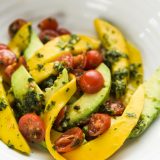The coastal highway in Dakar, Senegal, seems at first glance no different from a commuter road in London or Rome: busy and noisy. But after a few minutes, you pick out differences.
The vast oceanscape beyond the beach. Kids playing soccer in parks lining the highway. The cliffs in the distance where large houses cling tenaciously to bluffs above the fall to the ocean. Imposing red-bereted militia stationed every few blocks toting machine guns.
We pulled off the road into a private courtyard and were ushered into a house owned by a childhood friend of our host, Pierre Thiam. Both had grown up in Dakar. Thiam’s friend went to Harvard and became an investment banker, returning later to Senegal. Thiam, on the other hand, took the culinary route, becoming a celebrated New York chef.
Dakar is a tale of two cities. The street is a hubbub of vendors hawking myriad goods—from clothing to windshield wipers, from peanuts roasted in hot sand to mangos, bananas and coconuts—plus the colorfully painted public transportation system, “cars rapides” (“fast cars”), a fleet of 40-year-old Renault minibuses.
But inside a private home, the street noise ebbs and the quiet order of family life takes over.
We were led into the kitchen, where I met Alice, the charming generalissima, a true Senegalese culinary jefe, who would assist Thiam as we cooked some of his favorite recipes.
Senegalese cuisine is known for its gumbo and other stews, black-eyed peas, sweet potatoes, chicken yassa (cooked with onions), smoked seafoods, grilled meat skewers and its most famous dish, thieboudienne—rice and well-seasoned fish.
But Dakar has its surprises. Today, Thiam started off making the simplest salad, avocado and mango topped with rof.
What is rof? Chop—or pound in a mortar and pestle—parsley, garlic, scallions and Scotch bonnets with salt and pepper. That’s it. To make it more like a gremolata, add grated lemon or lime zest. For a dressing, add peanut or olive oil and perhaps lime juice and diced tomato. As is, it can be sprinkled over almost anything, even used as a stuffing for fish.
Both the avocados and mangos need to be firm and just barely ripe—not falling apart. Thiam fanned out the slices on a plate. He then demonstrated the proper use of a mortar and pestle. In Senegal, pestles are made of wood and are 3 feet tall; every kitchen has one. It is placed on the floor, often outside, and one sits on a small stool for comfort while pounding. Thiam knelt instead and made short work of the rof.
(Having watched another cook in Senegal use a pestle for pounding okra, I can say that although a food processor will work in pinch, a pestle is the superior tool for enhancing both flavor and texture.)
For the dressing, lime juice and zest were added to the rof along with some olive oil.
The rof doctored with lime was sprinkled on top of the avocado and mango slices as well as tomatoes, and the dressing drizzled over the top. A touch of Scotch bonnet chili heat, the fresh taste of parsley, the zing of lime zest: In 10 minutes we had the best tropical salad of my life.




